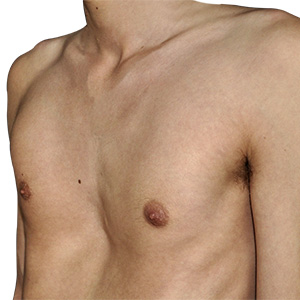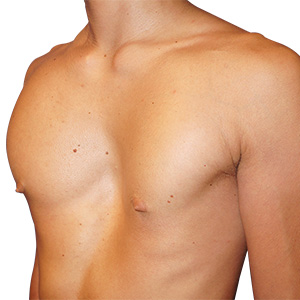Classification of Pectus Excavatum
Chin's classification is old but practical. It categorizes the different types of Pectus Excavatum according to their morphological characteristics.

CHIN 1: the malformation is symmetrical, deep and focused on the sternum.

CHIN 2: the malformation is symmetrical, shallower and extends to the pectoral regions.

CHIN 3: the malformation is asymmetrical and extends to the pectoral regions. The deviation is most often on the right side.
There are other types of Pectus, sometimes associated: mixed (mix of several types of Chin like deep right side and a left side more extended), arcuatum (with a low xiphoid depression), or hybrids (associated with Poland syndrome with agenesis of the major pectoral muscle).
Haller index
The Haller index was established in 1987 to assess the scale of a Pectus based on a calculation made on a digital image. It is established from a CT scan at the level of the deepest point of the depression: it is the ratio of maximum width and depth.
The Haller index allows measurement of the defect and Pectus Excavatum depth especially in women where the deformation is hard to evaluate because of the breast volume. The higher the Haller index, the deeper the Pectus Excavatum.
It is practical and still used, but it gives an imperfect idea of the importance of the depression and does not prejudge any possible and rare functional impact of the pectus.
Does Pectus have a functional impact?
Various studies have been conducted to determine whether this chest deformation affects patients' lung and heart capacities. While some researchers such as Malek MH, Berger DE and Marelich WD (4) have demonstrated a cardiovascular impact, others discount the hypothesis on the same bases (Guntheroth WG, Spiers PS)(5).
The works of Louis Daussy(6) (pulmonary) and Samir Shah(7) (cardiovascular) indicate that a sunken chest does not prevent a person from having a normal life. This is because the body and its organs develop alongside the condition and adapt to the malformation during growth.
Normally, the condition has no repercussion on cardiac or respiratory function, although this may be due to a restriction on physical activity caused by an altered body image.
If anything is uncertain during the clinical exam, a series of cardiopulmonary tests can determine the most appropriate surgical technique.
Psychological impact of Pectus Excavatum
Funnel chest is often difficult to accept both physically and psychologically. It also affects the patient's self-confidence and causes discomfort – sometimes profound – which can result in a complex. The psychological repercussions are especially important during adolescence, disrupting self-image and social relationships, and sometimes directly affecting the patient's ability to play sport.
The complex affects both men and women, regardless of the degree to which the condition causes the chest to sink. Patients limit activities and pastimes that involve exposing their chest, such as swimming, group sports and going to the beach...
Treatment







